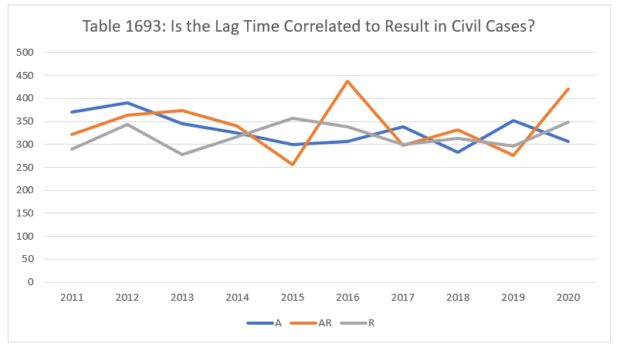This week, we're addressing a new issue: does the lag time from the grant of a party's petition for leave to appeal to a final decision from the Supreme Court tell us anything about what the result is likely to be? We begin with the civil docket for the years 2011 through 2020.
What we see in Table 1693 is that there does seem to be at least a mild relationship between lag time and result in civil cases (in the Table, "A" is affirmances, "R" is reversals, and "AR" is split results - affirmed in part, reversed in part). For six of the past ten years, civil affirmances took longer to decide than civil reversals. For the most part, the differences have not been minor. In 2011, affirmances averaged 370.4 days, while reversals averaged 288.77 days. In 2012, there was a month and a half difference - affirmances 390.5 days, reversals 343.45. In 2013, the difference was even bigger - 344.83 days for affirmances, 277.55 days for reversals. After three years where the relationship between lag time and result was weaker, the gap lengthened again in 2017 - 338.03 for affirmances, 299.5 for reversals. Reversals have been quicker in 2018 and 2020, but in 2019, affirmances averaged 352.3 days, while reversals averaged 295.96 days.

Join us back here next time as we review the criminal docket.
Image courtesy of Pixabay by 350543 (no changes).
Originally published by Illinois Supreme Court Review on the 1st of January, 2021
The content of this article is intended to provide a general guide to the subject matter. Specialist advice should be sought about your specific circumstances.
